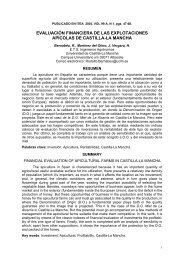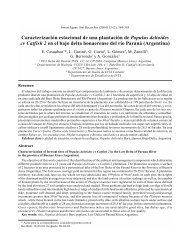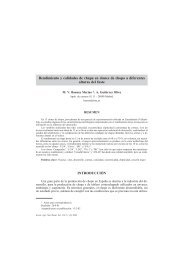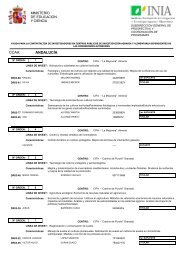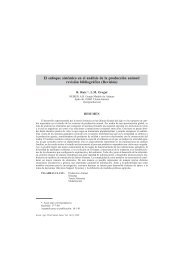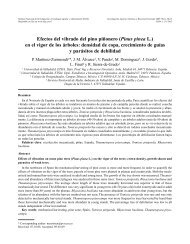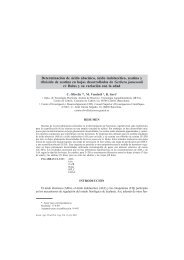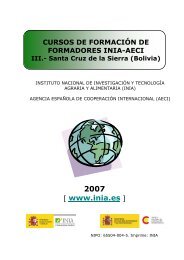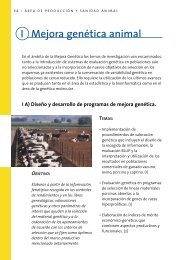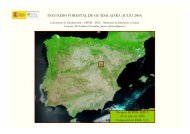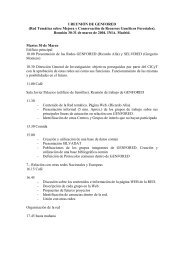Status of medicinal and aromatic plants in - Inia
Status of medicinal and aromatic plants in - Inia
Status of medicinal and aromatic plants in - Inia
Create successful ePaper yourself
Turn your PDF publications into a flip-book with our unique Google optimized e-Paper software.
PRESENTED PAPERS 135<br />
Ex situ conservation<br />
It is foreseen that <strong>in</strong> the near future emphasis will be put on preservation <strong>and</strong> conservation <strong>of</strong><br />
various MAP genetic resources. Several state <strong>in</strong>stitutions, together with non-governmental<br />
organizations <strong>and</strong> the private sector, have already been <strong>in</strong>cluded <strong>in</strong> attempts to ma<strong>in</strong>ta<strong>in</strong><br />
MAP diversity, such as the Federal M<strong>in</strong>istry <strong>of</strong> Agriculture, Federal Institute for Plant <strong>and</strong><br />
Animal Genetic Resources which does the collect<strong>in</strong>g, Federal Department for Nature<br />
Protection, Institute for Medic<strong>in</strong>al Plants Research "Josif Pančić" (Belgrade), Institute <strong>of</strong> Field<br />
<strong>and</strong> Vegetable Crops (Novi Sad) – Department for Medic<strong>in</strong>al Plants (Bački Petrovac),<br />
Faculties <strong>of</strong> Biology, Faculties <strong>of</strong> Agriculture (Universities <strong>of</strong> Belgrade, Novi Sad <strong>and</strong> Niš),<br />
etc.<br />
Ex situ conservation <strong>of</strong> MAPs is a very important activity. It <strong>in</strong>cludes field collections,<br />
herbaria, seeds <strong>and</strong> <strong>in</strong> vitro cultures <strong>in</strong> various <strong>in</strong>stitutes <strong>and</strong> faculties <strong>and</strong> especially <strong>in</strong> the<br />
Bank <strong>of</strong> Plant Genes <strong>of</strong> Yugoslavia. So far, 459 different genotypes (cultivars <strong>and</strong><br />
populations) <strong>of</strong> 190 MAPs have been collected (Kisgeči <strong>and</strong> Sekulović 2000).<br />
Besides the MAP field collection already established at the Institute for Medic<strong>in</strong>al Plants<br />
Research <strong>in</strong> Pančevo, near Belgrade, some attempts are currently be<strong>in</strong>g undertaken <strong>in</strong> order<br />
to establish a new collection <strong>in</strong> the hilly-mounta<strong>in</strong>ous region <strong>of</strong> Serbia where the majority <strong>of</strong><br />
the <strong>in</strong>digenous <strong>medic<strong>in</strong>al</strong> flora grows.<br />
Additional activities for ex situ conservation <strong>of</strong> MAP genetic resources are conducted by<br />
the Biological Institute <strong>in</strong> Belgrade <strong>in</strong> terms <strong>of</strong> <strong>in</strong> vitro propagation <strong>of</strong> many MAP species<br />
such as Gentiana sp., Centaurim umbellatum, Iris sp., Digitalis sp., Blackstonia perfoliata, Frangula<br />
alnus, Satureja sp. <strong>and</strong> many others. It is expected that endangered <strong>and</strong> vulnerable <strong>medic<strong>in</strong>al</strong><br />
<strong>plants</strong> will be more <strong>in</strong>tensively <strong>in</strong>cluded <strong>in</strong> programmes <strong>of</strong> <strong>in</strong> vitro propagation both by this<br />
<strong>and</strong> other scientific <strong>in</strong>stitutions.<br />
Dur<strong>in</strong>g the period 2001-2002, the team <strong>of</strong> scientists at the Institute for Medic<strong>in</strong>al Plants<br />
Research "Dr Josif Pančić" has exploited a number <strong>of</strong> types <strong>of</strong> terra<strong>in</strong> <strong>in</strong> Serbia <strong>and</strong><br />
Montenegro <strong>in</strong> order to fulfil the needs <strong>of</strong> the Bank <strong>of</strong> Plant Genes <strong>of</strong> F.R.Y. <strong>and</strong> preserve<br />
exist<strong>in</strong>g plant germplasm. Additional activities were focused on collect<strong>in</strong>g herbarium<br />
specimens <strong>and</strong> plant samples for further re<strong>in</strong>troduction, chemical screen<strong>in</strong>g <strong>and</strong> creation <strong>of</strong><br />
pharmacognostic maps.<br />
Activities required for MAP protection <strong>and</strong> conservation<br />
Besides the <strong>of</strong>ficial legislative, multidiscipl<strong>in</strong>ary MAP research <strong>and</strong> the establishment <strong>and</strong><br />
development <strong>of</strong> the MAP collection by the Bank <strong>of</strong> Plant Genes, other activities should be<br />
pursued to improve the current situation on MAP protection <strong>and</strong> conservation, such as:<br />
- Investigations on possibilities for re<strong>in</strong>troduction <strong>and</strong> breed<strong>in</strong>g <strong>of</strong> the most endangered<br />
wild <strong>medic<strong>in</strong>al</strong> <strong>and</strong> <strong>aromatic</strong> <strong>plants</strong>;<br />
- Reproduction <strong>and</strong> multiplication <strong>of</strong> vulnerable <strong>and</strong> endangered species directly <strong>in</strong><br />
natural habitats either by sow<strong>in</strong>g or by vegetative propagation;<br />
- Protection <strong>of</strong> MAP habitats where the most endangered <strong>medic<strong>in</strong>al</strong> <strong>plants</strong> are present;<br />
- Limited <strong>and</strong> controlled collect<strong>in</strong>g;<br />
- Substitution <strong>of</strong> MAP collect<strong>in</strong>g with production on plantations <strong>and</strong> <strong>in</strong> vitro<br />
propagation;<br />
- Education programmes for collectors, breeders <strong>and</strong> other <strong>in</strong>terested parties;<br />
- Supervision <strong>and</strong> <strong>in</strong>spection at all levels.




